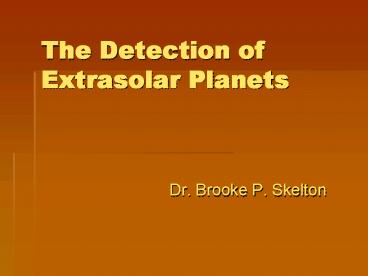The Detection of Extrasolar Planets - PowerPoint PPT Presentation
1 / 43
Title:
The Detection of Extrasolar Planets
Description:
The orbit of a planet is an ellipse with the Sun at one focus. ... 3. Calculate velocity of planet using Newton's 2nd Law and Law of Gravity. ... – PowerPoint PPT presentation
Number of Views:46
Avg rating:3.0/5.0
Title: The Detection of Extrasolar Planets
1
The Detection ofExtrasolar Planets
- Dr. Brooke P. Skelton
2
GRAVITY
3
Our Solar System
By Calvin J. Hamilton http//www.solarviews.com/c
ap/misc/ss.htm
4
Our Solar System, seen from 4 billion miles
Images taken by Voyager 1 on February 14, 1990
Note 4 billion miles 43 AU 0.0002 pc
5
Formation of a Star
From Pasachoff, Astronomy From the Earth to the
Universe, 4th Edition
6
Proplyds in Orion Nebula
7
Detecting Extrasolar Planets
- Astrometry
8
Newtons Law of Gravity
- G M1 M2
F
R2
9
Astrometry
http//www.hao.ucar.edu/public/research/stare/sear
ch.html
10
Detecting Extrasolar Planets
- Astrometry
- Pulsar Timing Measurements
11
Pulsar Timing Variations
http//www.astro.psu.edu/users/alex/pulsar_planets
_text.html
12
Detecting Extrasolar Planets
- Astrometry
- Pulsar Timing Measurements
- Radial Velocity Measurements
13
(No Transcript)
14
Radial Velocity Variations
http//cfa-www.harvard.edu/afoe/orbits/rhoCrB-orbi
t.mpg
15
Newtons Law of Gravity
- G M1 M2
F
R2
16
Keplers Laws
- The orbit of a planet is an ellipse with the Sun
at one focus.
- A planet travels fastest when closest to the Sun
and slowest when farthest.
- There is a relationship between the orbital
period of a planet and its average distance from
the Sun that depends on the mass of the central
body.
17
Deriving Planetary Masses
- Observe period and amplitude of stars motion.
2. Derive size of orbit using Keplers 3rd Law.
http//exoplanets.org/graphics/kepslaw.gif
P period of orbit K amplitude V sin i i
inclination of orbit with respect to
observer
18
Deriving Planetary Masses
- Observe period and amplitude of stars motion.
2. Derive size of orbit using Keplers 3rd Law.
3. Calculate velocity of planet using Newtons
2nd Law and Law of Gravity.
http//exoplanets.org/graphics/kepslaw.gif
P period of orbit K amplitude V sin i i
inclination of orbit with respect to
observer
F ma
19
Deriving Planetary Masses
- Observe period and amplitude of stars motion.
2. Derive size of orbit using Keplers 3rd Law.
3. Calculate velocity of planet using Newtons
2nd Law and Law of Gravity.
http//exoplanets.org/graphics/kepslaw.gif
P period of orbit K amplitude V sin i i
inclination of orbit with respect to
observer
20
Deriving Planetary Masses
- Observe period and amplitude of stars motion.
2. Derive size of orbit using Keplers 3rd Law.
3. Calculate velocity of planet using Newtons
2nd Law and Law of Gravity.
http//exoplanets.org/graphics/kepslaw.gif
P period of orbit K amplitude V sin i i
inclination of orbit with respect to
observer
4. Estimate mass of planet with momentum
conservation.
MplVpl MV
21
Deriving Planetary Masses
- Observe period and amplitude of stars motion.
2. Derive size of orbit using Keplers 3rd Law.
3. Calculate velocity of planet using Newtons
2nd Law and Law of Gravity.
http//exoplanets.org/graphics/kepslaw.gif
P period of orbit K amplitude V sin i i
inclination of orbit with respect to
observer
4. Estimate mass of planet with momentum
conservation.
Mpl sin i MK / Vpl
22
Detecting Extrasolar Planets
- Astrometry
- Pulsar Timing Measurements
- Radial Velocity Measurements
- Microlensing
23
Microlensing
http//www.exoplaneten.de/MACHO-98-BLG-35/english.
html
http//sirrah.troja.mff.cuni.cz/mira/astronomicky
_kurz_hphk/Exoplanety/037microlensing_16-5.png
http//www.nd.edu/srhie/MPS/
24
Detecting Extrasolar Planets
- Astrometry
- Pulsar Timing Measurements
- Radial Velocity Measurements
- Microlensing
- Direct Imaging
25
Imaging in the near-infrared
26
Detecting Extrasolar Planets
- Astrometry
- Pulsar Timing Measurements
- Radial Velocity Measurements
- Microlensing
- Direct Imaging
- Imaging of Planetary Transits and Eclipses
27
Seeing extrasolar planets
Eclipse of planet by star
Transit of planet across star
http//www.hao.ucar.edu/public/research/stare/hd20
9458.html
http//www.hao.ucar.edu/public/research/stare/tres
1_2.html
http//www.hao.ucar.edu/public/research/stare/curv
es.html
28
So what do we find?
29
Detected Extrasolar Planets
- Astrometry 0 candidates
30
The 61 Cygni system
http//www.dibonsmith.com/cyg_61.gif
Photo by Francois du Toit http//home.intekom.com/
franlet/astronomyPAGE108.htm
31
Detected Extrasolar Planets
- Astrometry 0 candidates
- Pulsar Timing 4 planets in 2 systems
32
PSR B125712
http//www.uranos.eu.org/biogr/wolsze.html
33
Detected Extrasolar Planets
- Astrometry 0 candidates
- Pulsar Timing 4 planets in 2 systems
- Direct Imaging 3 very large planets
34
GQ Lup and AB Pic
M 13.5 MJ at R 275 AU
M 21.5 MJ at R 103 AU
35
Detected Extrasolar Planets
- Astrometry 0 candidates
- Pulsar Timing 4 planets in 2 systems
- Microlensing 3 planets 2 Jupiter-like and one
Earth-like
- Direct Imaging 3 very large planets
- Imaging of Transits 1 Jupiter-like planet
36
OGLE 2005-BLG-390L
http//planet.iap.fr/PublicCurves/OB05390p.gif
Mass 5.5 ME at R 2.6 AU
http//planet.iap.fr/OB05390.news.html
37
Detected Extrasolar Planets
- Astrometry 0 candidates
- Pulsar Timing 4 planets in 2 systems
- Radial Velocity Measurements 171 planets in 147
planetary systems most quite large (Saturn- and
Jupiter-like)
- Microlensing 3 planets 2 Jupiter-like and one
Earth-like
- Direct Imaging 3 very large planets
- Imaging of Transits 1 Jupiter-like planet
38
51 Pegasi
http//exoplanets.org/esp/51peg/51peg.shtml
http//exoplanets.org/esp/51peg/51peg.shtml
http//www.exoplaneten.de/51peg/english.html
39
www.physics.sfsu.edu/gmarcy/planetsearch/7504/750
4.html
www.exoplanets.org
40
A Very Eccentric Planet
http//cfa-www.harvard.edu/afoe/orbits/16CygB-orbi
t.mpg
41
Masses and Orbits of Extrasolar Planets
www.exoplanets.org
42
A Planetary System
http//exoplanets.org/esp/upsandb/upsandb.shtml
43
Upsilon Andromedae
http//antwrp.gsfc.nasa.gov/apod/ap990422.html
http//exoplanets.org/esp/upsandb/upsandb.shtml
http//www.exoplaneten.de/upsand/english.html
44
F ma
MplVpl MV
Mpl sin i MK / Vpl
45
Newtons Form of Keplers Third Law
- 4p2
a3
P2
G(m1 m2)
P period of orbit a semimajor axis of
orbit m1, m2 masses of Sun and planet
46
A Sample of Observed Planets
Our Solar System
First known extrasolar planet, 51 Pegasi
First known extrasolar system, Upsilon Andromedae































